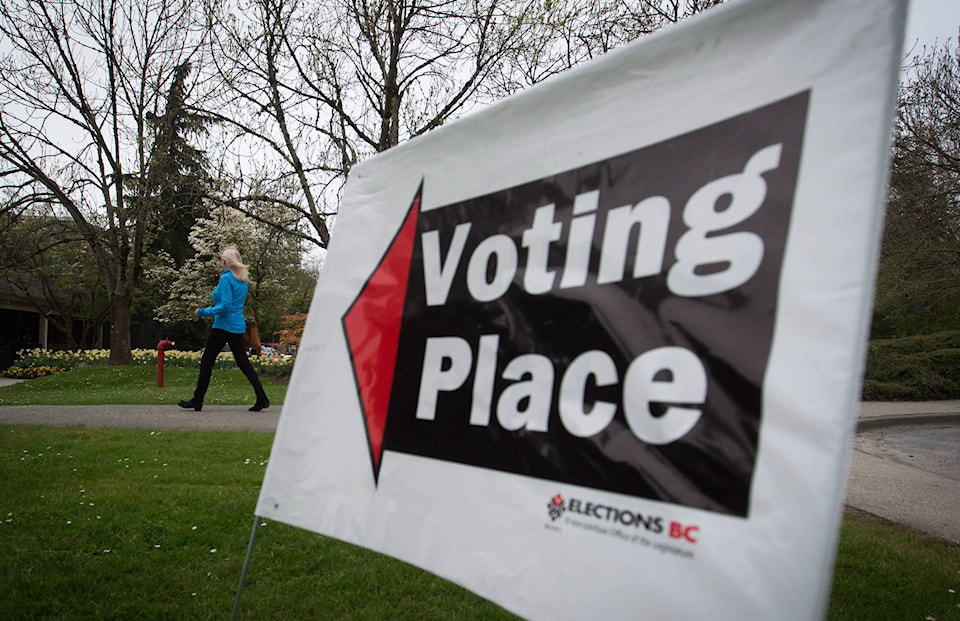Nearly 700,000 British Columbians have requested to vote in the provincial election by mail-in ballots sa���ʴ�ý� and data shows a personsa���ʴ�ý�s inclination to do so could be linked their political views and where they live.
Earlier this week, Elections BC said it had received 670,033 requests for the ballots as of Oct. 12 from the provincesa���ʴ�ý�s 3,485,858 registered voters, representing nearly 20 per cent of the electorate.
Looking at the 10 most left-wing versus the 10 most right-wing ridings in the province sa���ʴ�ý� according to Vote Compass data from the last provincial election sa���ʴ�ý� there is a stark divide.
The average percentage of voters from the right-leaning ridings who requested a mail-in ballot was just over 12 per cent. In the left-leaning ridings nearly 25 per cent of voters requested ballots.
Vote Compass bases its political leaning analysis on residentssa���ʴ�ý� answers to 30 issues-based questions, as opposed to self-declared political affiliation.
Richard Johnston, a political science professor at the University of British Columbia, told Black Press Media he had not done a serious evaluation of Elections BCsa���ʴ�ý�s mail-in ballot data, but thought there could be something to the right-left divide.
sa���ʴ�ý�I donsa���ʴ�ý�t have a comprehensive theory here, but if the pattern is as you describe it, itsa���ʴ�ý�s oddly consistent with whatsa���ʴ�ý�s going on in the United States,sa���ʴ�ý� he said.
sa���ʴ�ý�There, of course, we attribute it to the politicization of the whole process thanks to Trump trying to trash the mail-in ballots, but I wonder if there is something deeper going on.sa���ʴ�ý�
READ MORE:
Johnston offered another potential factor on why left-leaning ridings might have such a dramatically higher uptake of mail-in ballots.
sa���ʴ�ý�I wonder if, in the case of the general left-versus-right, that the NDP was on election alert right from the start and basically urged its people to go get their ballots so theresa���ʴ�ý�d be nothing getting in the way of the votes on Election Day,sa���ʴ�ý� he said.
Comparing the 10 most rural and 10 most urban ridings sa���ʴ�ý� based on population density data from a 2015 BC Electoral Commissionsa���ʴ�ý�s report sa���ʴ�ý� there is also a marked difference in uptake.
On average, in the most urban ridings, 20 per cent of voters requested ballots while only 10.6 per cent did in the rural ones.
Of course, there is significant overlap between political leaning and the rural-urban divide with urban districts tending toward more progressive candidates while rural districts tend to be more conservative.
Johnston said he expected to see a rural-urban difference, but was surprised by how dramatic it was.
sa���ʴ�ý�I was struck that, of course, the total size of the population is smaller, but just eyeballing it, Skeena and Stikine struck me as remarkably low,sa���ʴ�ý� he said.
In Skeena, just 1,639 of the 21,262 registered voters, or 7.7 per cent, have requested packages while only eight per cent of voters in Stikine (1,141 of 14,250) have taken up the offer.
Even more remarkable are two Northeast B.C. ridings at 5.5 per cent for Peace River North and 4.2 per cent for Peace River South.
Johnston suggested that could be the COVID-19 factor playing out even though he thought northerners would embrace the convenience of mail-in voting.
sa���ʴ�ý�What thought that occurred to me there was that theresa���ʴ�ý�s less fear of coronavirus there than in urban ridings generally because otherwise I thought how far do you have to go to get to a poll?sa���ʴ�ý� he said. sa���ʴ�ý�Yousa���ʴ�ý�d have to go rather further in a rural place than in urban ones, but then again, yousa���ʴ�ý�re also less likely probably to encounter someone who has tested positive.sa���ʴ�ý�
Johnston was also struck by the number of mail-in ballot requests from another region of the province.
sa���ʴ�ý�What leapt off the table for me was Vancouver Island, that urban or rural, Vancouver Island ridings seem to have a dramatically higher number of requests relative to registered voters,sa���ʴ�ý� he said.
For the 14 Vancouver Island ridings the average was 26 per cent with the low being North Island at 16.7 per cent and the high Victoria-Beacon Hill at 35.4 per cent.
Johnston speculated the interest on the island, where the Green Party held three seats at the dissolution of the legislature, could be related to the very recent election of Sonia Furstenau as the partysa���ʴ�ý�s leader.
sa���ʴ�ý�There may have been Green mobilization thatsa���ʴ�ý�s a byproduct of the leadership convention,sa���ʴ�ý� he said.
With many pundits positing mail-in voting could play a significant role in the outcome of the election, there are a number of swing ridings worth reviewing. The election prediction site 338Canada lists 12 districts that are too close to call.
Of these, only Skeena and Saanich North and the Islands fall dramatically outside the provincial average in terms of mail-in ballots requested at 7.7 per cent and 30.1 per cent of the electorate respectively. The rest fall within the range of 13.4 per cent (Boundary Similkameen) and 26 per cent (North Vancouver-Seymour).
Elections BC also reported it has already received back 138,500 of the packages, roughly 21 per cent of those issued as of Oct. 12. In the 2017 election only 6,500 people voted by mail.
Voters have right up to election day to request a package as long as it is received by Elections BC by 8 p.m. on voting day, Oct. 24.
Because up to 800,000 people may ultimately cast their vote by mail, officials have said it could be weeks before the final results are known.



